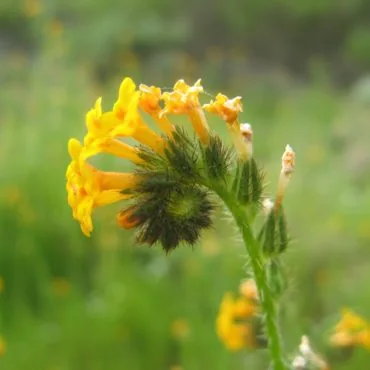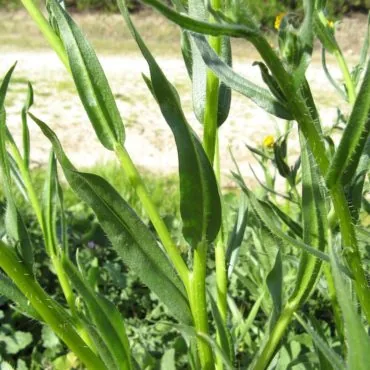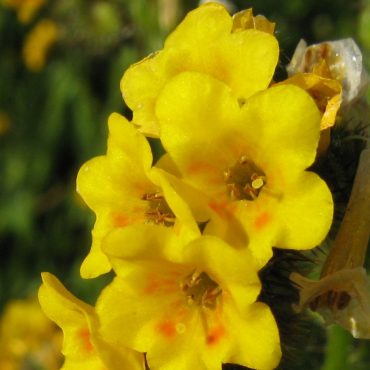Coast fiddleneck (Amsinckia intermedia) is a colorful but bristly annual that is common along the trails throughout the Reserve. Flowers are born sequentially along a coiled stem. As the plant grows, the stem uncoils, and new flowers emerge, while the old flowers develop into seed pods along the lower part of the stem. The structure is reminiscent of a fiddlehead, which gives this plant its common name.
Early in the season, plants are small and the flowers appear as small bright stars among the green grasses. By summer, however, plants often become tangles two or more feet in height and have a weedy appearance.
Coast Fiddleneck
Amsinckia intermedia
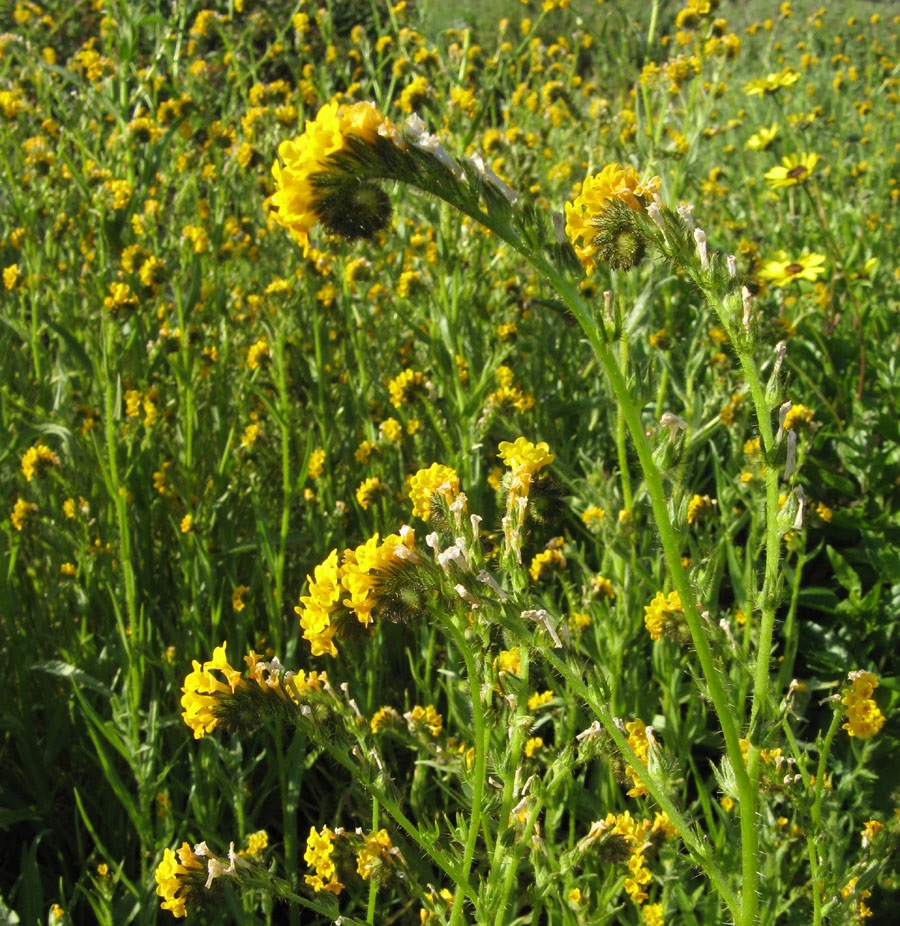
Other Common Names:
common fiddleneck, rancher's fireweed, yellow fiddleneck
Description 2,4,11,59,144
Coast fiddleneck is an upright annual rarely exceeding three feet (90 cm) in height. One or more branching stems grow from the base, producing a few upright lateral branches. Stems, leaves and calyx are covered with stiff hairs that project straight out, giving the plant a scratchy feeling.
The cotyledons are a distinctive, deeply lobed, Y-shape. Young plants are rosettes of linear to narrowly lanceolate leaves. These rosettes disappear as the stems elongate. Cauline leaves are alternate and mostly sessile, to six inches (15 cm) long, linear to narrowly lanceolate. Leaf tips are more or less pointed with a small, tan, terminal tip.
Flowers are born along one side of a terminal stalk that is initially tightly coiled, unfurling as the buds mature. Flowers open near the top of the coil, and seeds develop below along the elongating stalk. The entire structure resembles a fiddlehead, giving the plant its name.
Flowers are bisexual and radially symmetrical. The five sepals are free. The five petals are united into a five-lobed funnel with a flaring mouth. Flowers are less than 1/2 inch long (1.1 cm), yellow-orange in color and usually have five orange spots near the top of the throat. The five stamens are fused to the corolla throat and do not extend beyond the corolla tube. There is a single pistil with a four-lobed, superior ovary, a single style and a two-lobed stigma. Flowers begin to open in early February and continue through May.1
The fruit consists of four one-seeded segments. On maturity, the fruit splits into four nutlets, which are tan, rounded-triangular in shape and have sculpted, warty surfaces.
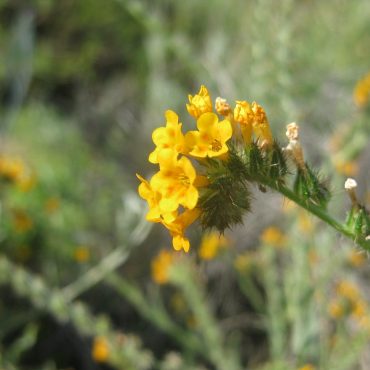
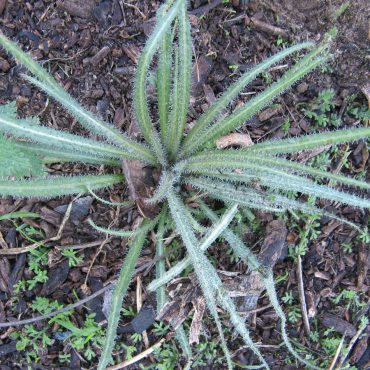
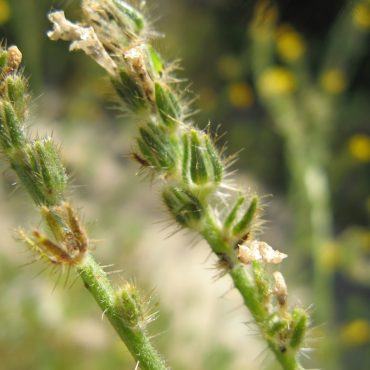
Distribution 7,43,89
Coast fiddleneck is native to western North America from Alaska to Baja California and northwestern Mexico but has been introduced elsewhere. It has naturalized in Great Britain and is considered a weed in Australia.41
In California, coast fiddleneck is associated with a variety of vegetation types below 5600 feet (1700 m). It is especially abundant in open areas such as meadows, grasslands and disturbed areas. It is considered a weed by many farmers.144
In the Reserve, coast fiddleneck is common along the trails on the south side of the Reserve and on Stonebridge Mesa, and it rapidly fills in the gaps in our new restoration areas.
Learn more about plant vegetation types here
Classification
Coast fiddleneck (Amsinckia intermedia) is an annual dicot in the borage family (Boraginaceae). This family is large, and until recently it was split it into several smaller families.41,59 Members of the borage family, as currently recognized, are characterized by flowers that are produced along a coiled stalk and by a fruit that splits into four one-seeded nutlets.2, 44 Many of the best known members of this family are not native, including culinary borage and the garden heliotrope and forget-me-not.41
Other members of the borage family in the Reserve include common phacelia (Phacelia distans), fiesta flower (Pholistoma auritum) and common cryptantha (Cryptantha intermedia).48
Coast fiddleneck is part of a large, highly variable species in which component species and subspecies are often difficult to distinguish.”11 More than 100 names were applied to different forms before they were recognized to be parts of one species complex.34, 43
At present, several recent references11, 41, 43, 83 list coast fiddleneck as A. menziesii var. intermedia, but, because there is some question as to whether this name was properly published, other references2, 4, 8, 59 have retained the earlier name A. intermedia, while recognizing that it might be better treated as part of the A. menziesii complex.2, 4
Alternate Scientific Names:
Amsinckia menziesii var intermedia

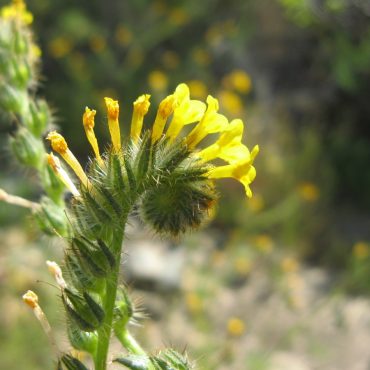
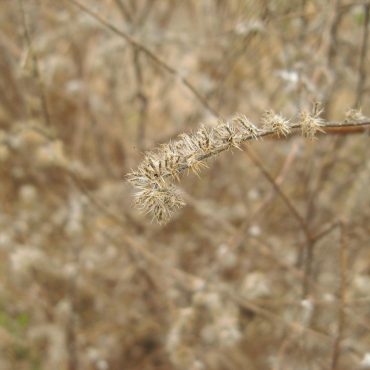
Ecology 43,323
Although coast fiddleneck is often valued as a component of native vegetation and is used for erosion control and restoration, it has several attributes that make it a “weed” in the eyes of some. It produces a large number of heavy seeds during the growing season. Although a few seeds may be transported away when the prickly fruit becomes tangled in animal fur or human socks, most fall to the ground directly around the parent plant. This provides a large seed bank for the next year, in an area that has proved successful for the parent plant. Because the seeds germinate early, they claim space and water before many other plants have sprouted, outcompeting crops and forage plants in cultivated fields and rangelands.
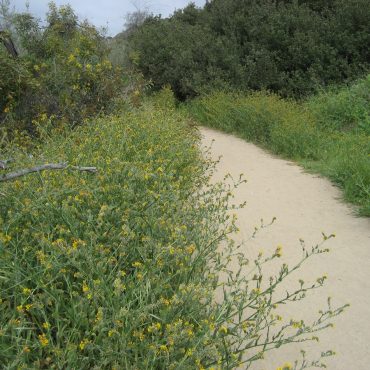
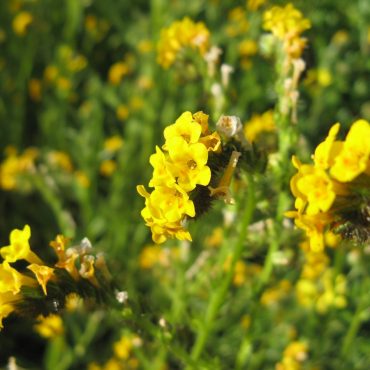
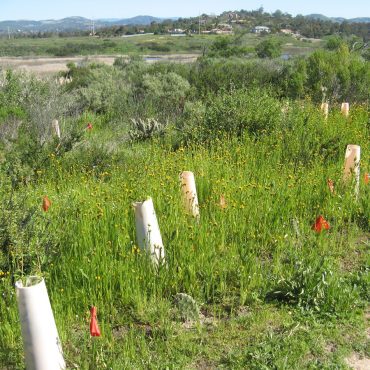
Human Uses
The Chumash ground and toasted the seeds and made them into pinole. The seeds were reported to have a good flavor and a pretty color.15
On the other hand, plants, especially the seeds, contain alkaloids that cause severe liver damage and are toxic to livestock.43,144,323 One report claims that cattle dislike the plant in the field and tend to avoid grazing on it,323 but this is contradicted by another that says the plant is preferentially eaten by cattle.34,35 These differences in food quality might be caused by regional variability in the toxicity of fiddlenecks, but until this paradox is understood, we do not recommend nibbling on the seeds.
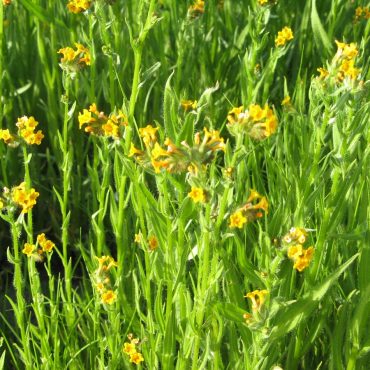
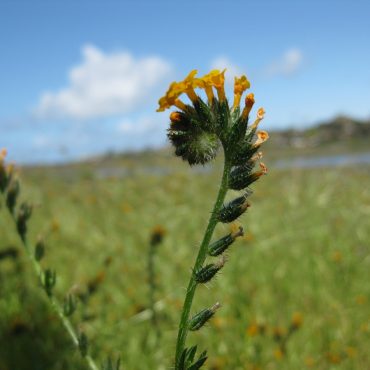
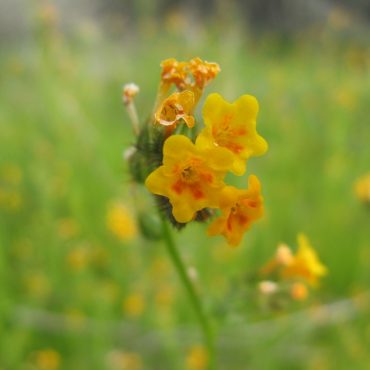
Interesting Facts 21,41
The genus of coast fiddleneck, Amsinckia, was named in honor of Wilhelm Amsinck (1752-1831), a patron of botany and the Botanical Garden in Hamburg. The Amsinck family members were prominent merchants in several countries and the Amsincks were one of Hamburg’s great business families over many centuries, its members attaining the highest positions in Hamburg society. In 1802, Wilhelm was elected the first mayor (Burgermeister) of the free imperial city of Hamburg.
